#moveable base units
Explore tagged Tumblr posts
Text





"BAMBI, 1988
This July 8 to Aug 4, 1988 Happy Meal was a tie-in with the re-release of the 1942 Walt Disney film classic, Bambi, based on the story by Felix Salten. Four poseable characters with moveable limbs or wings came in a clear polybag with an insert card. Some cards featured information regarding a free Bambi poster with any Bambi collection purchase from Sears. The "Under 3" premiums were not poseable. Each of the 4 boxes could be cut apart and assembled into a Bambi playset. counter display unit was battery operated."
#childhood#nostalgic#nostalgia#toys#1988#bambi#mcdonalds#happy meal toys#disney nostalgia#80s toys#80s nostalgia#fast food toys#friend owl#mcdonald's happy meal#retro#retro toys#late 80s#early 90s#kidcore#nostalgiacore#disney#toys and games#vintage toys#vintage#1980s#80s#Disney#disney bambi#flower the skunk#nostaligiacore
32 notes
·
View notes
Text




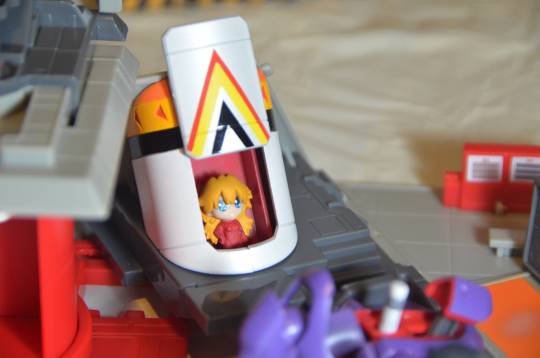
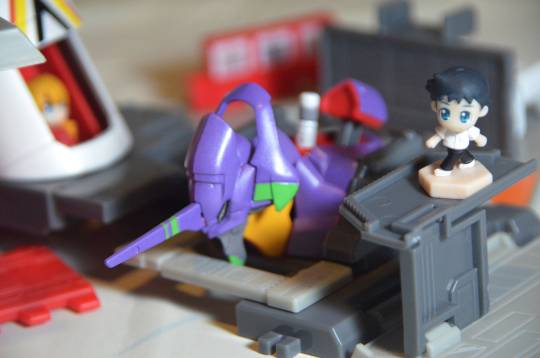

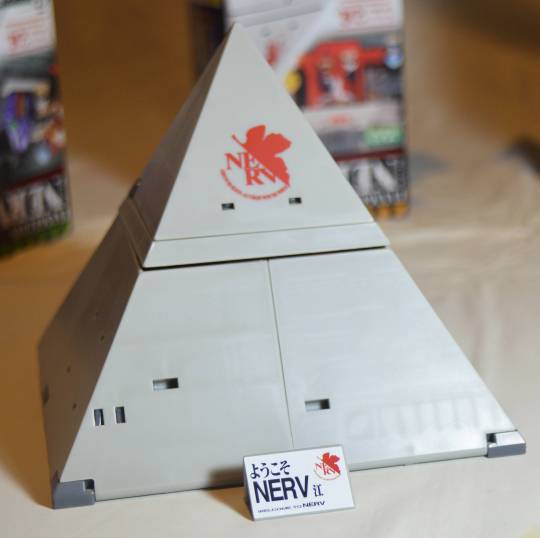

A fun project on the side while doing a photoshoot of some Eva figures, finally assembling the 'Petit Eva - Welcome to NERV Base' minifigure set (that I hadn't even opened in 3 whole years). The full set is made up of 5 pieces: 1) Entrance and Escalator + Unit-00's Containtment area. 3) Entry Plug Simulator + Vending machines. 4) Unit-00's cage + Infirmary. 5) Central Dogma with Lilith inside impaled by the Longinus Spear. 6) Top of the Pyramid with Command Center. All pieces connect to each other, which can be transformed/closed into NERV HQ's Pyramid structure (for easy storage). Each piece has a moveable mechanism of a sort such as the Entry Plug Simulator door (open/closes), NERV HQ's mechanical stairs (platform goes up/down), or Unit-01's Entry Plug hatch (open/closes). Comes with several accessories: 5 minifigures (Shinji, Asuka, Rei, Misato and Gendo); Lilith with its very tiny Longinus Spear; an infirmary bed; the door for the Entry Plug Simulator; Unit-01's horn; the Command Center graphic display, and a small 'welcome to NERV' sign. This set took me years to find, precisely because each piece was sold separately but didn't want to risk not finding the missing ones, so had to patiently wait for a listing of the whole set. Since I have a weak spot for Lego and miniature sets (the Pokemon mini sets come to mind) this was one of my most wanted pieces of Evangelion merch ever; very happy I found it -and got to assemble it- at last! And here's a bonus: there's a secret watermelon garden under one of the pyramid's corners, wonder who it could belong to...

#evangelion#nge#neon genesis evangelion#eva merch#eva figures#petit eva#puchi eva#shinji ikari#rei ayanami#asuka soryu langley#misato katsuragi#gendo ikari#welcome to nerv base#welcome to nerv hq#zedit#zfigures#fav
163 notes
·
View notes
Text


#RudyTuesday WPTZ in Philadelphia was the third commercial television station licensed in the United States, the first outside New York City, and the first not owned and operated by a network. Here are photos of the station's football game coverage in the early 1950s, used in discussing the first commercially successful zoom lens.
Rudy Bretz called the Zoomar lens "probably the most important accessory to be added to standard TV equipment," and explained, "The Zoomar lens effects the change in focal length simply by sliding one moveable barrel (carrying 3 lens groups) within the main lens barrel (which holds stationary the rest of the 28 lens elements)."
"Most stations use two cameras on football and place them together on the 50-yard line... A position halfway up the stands is often used, just above an entrance, where there will be no one to jump up suddenly and wave his arms in front of the lens... One camera with a Zoomar can do the work of two at a football game." – "Remote Pickups," Techniques of Television Production, by Rudy Bretz (1953)
The second picture is captioned: "WPTZ camera on field mounted on a studio mike-boom base."
One in a series of photos from the Rudy Bretz papers at UMD.
10 notes
·
View notes
Text
James Henry Greathead

James Henry Greathead a mechanical and civil engineer who lived between 1844 and 1896, was born in Grahamstown, South Africa; to parents of English descent, his grandfather had emigrated to South Africa in 1820
James Henry Greathead is known for his work on the London Underground railways, Winchester Cathedral, and Liverpool overhead railway, he was also one of the earliest proponents of the English Channel, Irish Sea and Bristol Channel tunnels, his invention of the Greathead Shield is why the London Underground is colloquially named the "Tube." as the Greathead Shield could build round tunnels hence tube.
James Henry Greathead''s shield design was built on the work of Marc Isambard Brunel below is a paragraph from James Henry Greathead's Wikipedia page explaining the difference between James Henry Greathead's tunnelling shield and Marc Isambard Brunel's tunnelling shield
"Brunel's shield was rectangular and comprised 12 separate, independently moveable frames; the Greathead solution was cylindrical, and the "reduction of the multiplicity of parts in the Brunel shield to a single rigid unit was of immense advantage and an advance perhaps equal to the shield concept of tunnelling itself", though the face was still dug out by manual labour to begin with. Greathead's patented Shield for Tunnelling Soft Earth used water jets under pressure at the tunnel face to assist in cutting through soft earth as described in the patent. Pneumatic tunnel pressurisation was used to ensure better safety for workers by equalising internal tunnel pressure to its estimated exterior underground pressure beneath the water."
interesting fact you can still see a Greathead shield embedded into the tunnel wall at the bank underground station, the Greathead shield in question was used during the tunnelling of the original Waterloo & City Line in 1898, you can see a picture of the Greathead shield at bank underground station on the article linked below
James Henry Greathead Statue:-
below is a picture of the statue of James Henry Greathead from the James Henry Greathead's Wikipedia page, here are some interesting facts about the statue, the statue is next to the bank underground station in London and on the statue between the base and the statue itself are some metal grilles these grilles are connected to the bank underground station's ventilation system.

References:-
3 notes
·
View notes
Note
God republicans are so funny about the ACA. It’s not unpopular. Cope and seethe. “The February 2024 Health Tracking Poll shows that about six in ten U.S. adults (59%) hold a favorable opinion of the ACA while about four in ten (39%) hold a negative opinion of the law. Views of the ACA are still largely driven by partisanship; nearly nine in ten Democrats (87%) along with over half of independents (55%) view the law favorably, while about two thirds of Republicans (67%) hold unfavorable views.” The only people who dislike it are people who already think like you. Which most people don’t. Just for the record I don’t think taxation is theft. I actually like having a water and sewer system.
Even for republicans talking about repealing it isn’t important or popular. “Republican voters are far less interested than Democrats in hearing the candidates talk about the health care law, according to new polling data released Friday by KFF, formerly known as the Kaiser Family Foundation. Only 32 percent of self-identified Republican voters think it’s very important for candidates to talk about the future of the Affordable Care Act, the poll shows, compared to 70 percent of Democrats.” You might not want to hear about it, but you’re not in the Democratic base. No one thinks they’re ever going to convince you to vote for Joe Biden so why would they waste time trying to pander to your vote when you disagree with the base on basically everything?
(Also you should read the fact sheet re: 2 million more homes. They’re not saying the government will build 2 million more homes, they’re going to use market interventions to encourage more building AND more preservation. Between preserving NOAH and incentivizing more affordable development and more affordable unit types- triplex, duplex, etc, we can manage the supply side challenges. They’re also encouraging communities to loosen their zoning codes through grant funding, a pilot version which started last year- the PRO housing grant that was very popular with municipalities. This is NOT a call for the government to personally pay for more housing, often it’s just the government encouraging more diverse housing typologies to even be allowed to be built.)
You're either new here or think you're smarter than you are.
I don't care what hardcore Republicans think about ACA and I don't care what hardcore Democrats think about it. No one's changing their minds. They're going to vote how they're going to vote. I don't know why Biden is wasting time talking to hardcore Dems now when he should be talking to independents, who are still moveable. And ACA is not the talking point you want to hit if you're talking to independents.
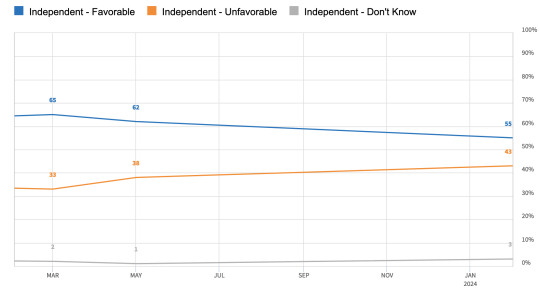
The KFF poll you cite found that Obamacare favorability is down 10 points since last year among Independent voters.
ACA is slightly above water with them now. But this trend does not look good for Dems. And it gets worse when you start to talk about the specifics of the package beyond the Dems' two favorite talking points - and even those fall apart pretty quick when you poke at them a little. This is a very flimsy case for Dems.
But the good news for you is that healthcare is not a top issue for voters in this election. Biden should consider that a win, in and of itself, and not remind voters that he's done pretty much nothing on it since he was vice president because here's your other problem, according to that same KFF poll:

Even among people who like Biden more than Trump in regards to healthcare, they pretty much all agree that Biden still sucks.
This is not about my opinion. If you want my opinion, I'd be happy to talk about how an Obamacare plan would cost me three times as much as the non-ACA plan that covers exactly the same stuff. I'd be happy to talk about how the government considers me uninsured because I obviously picked the cheaper plan and if it weren't for Trump, I'd be shelling out money for penalties and fines every year. I'd be happy to talk about how the changes to Medicaid billing that were passed alongside ACA created an entire new industry of leeches who have driven the cost of prescriptions up dramatically, reduced the patient choice, and worsened health outcomes. I'd be happy to talk about how those billing changes also forced independent practices out of business and caused the entire industry to consolidate into a small number of massive organizations who now control pricing at their own whims, which means costs have gone up even more.
But like you said, my mind is made up. I'm not voting for Joe. So my opinion isn't that important. That's why I'm looking at this as nothing more than electoral strategy. And the Dems are making a mistake.
And thank you for directing me to the White House 'fact' sheet on the housing stuff. It's actually worse than I thought. Can't wait to see my rent go up more because of this. I thought we were just going to make it harder for me to buy a home one day but I guess I get to enjoy the fun while I'm still a renter. This plan is a fucking joke.
6 notes
·
View notes
Text
Where to Buy Mandir Online for Every Budget
Creating a peaceful corner in your home for prayer and devotion has never been easier. Thanks to the growing online market, you can now buy mandir online that fits your space, budget, and style with just a few clicks. Whether you want a compact pooja unit for a small apartment or a large wooden temple for a traditional setting, there are countless options available across various price ranges.
In this guide, we’ll help you explore where and how to buy the best mandir for home online — without breaking the bank.
Why Buy Mandir Online?
Buying a mandir online is convenient, affordable, and offers far more variety than local stores. From compact wall-mounted mandirs to premium marble temples, online platforms offer the flexibility to compare materials, sizes, customer reviews, and pricing before making a choice.
When you buy mandir online, you also get access to:
Customer ratings and real images
Delivery and easy installation
Budget filters and customization options
Quality checks and return policies
Shopping for a pooja mandir online has never been this simple and secure.
Budget-Wise Guide to Buy Mandir Online
Let’s explore your options based on how much you want to spend:
💰 Low-Budget (₹1,000 — ₹4,000)
Perfect for compact homes or students living in rentals. You’ll find simple mandir designs in MDF, engineered wood, and foldable formats. These options are space-saving and lightweight, ideal for wall-mounting or setting on a small shelf.
Best websites:
Amazon
Flipkart
Pepperfry (affordable MDF options)
💸 Mid-Range (₹4,000 — ₹15,000)
If you want a balance between style and functionality, this price range is ideal. You’ll find beautiful pooja mandir online options in sheesham wood, engineered wood, and even with built-in drawers or LED lighting.
Features to expect:
Carved doors or jaali work
Storage cabinets
Elegant polish or color options
Best websites:
Urban Ladder
WoodenStreet
Pepperfry
💎 Premium Range (₹15,000 — ₹50,000+)
Looking for something luxurious? Go for handcrafted wooden or marble mandirs that reflect temple architecture. These often come with domes, steps, pillars, and ample storage.
Customization and exclusive designs are available at:
WoodenStreet
Craftatoz
IndiaMART
Temple Hub — mandirstudio.in (For handpicked designer mandirs for all budgets)
Temple Hub — A Trusted Source for Elegant Mandirs
If you’re someone who prefers authentic, high-quality mandir designs, Temple Hub is a must-visit. Their website mandirstudio.in offers a curated selection of mandirs made with fine craftsmanship and spiritual detailing. From modern pooja shelves to traditional wooden temples, they cater to a wide range of home sizes and budgets.
Whether you’re looking for minimalism or grandeur, Temple Hub provides a seamless experience to buy mandir online with trust and style.
How to Choose the Right Mandir for Home Online
Before finalizing your purchase, here are a few tips to consider:
Size Matters: Measure your space in advance to ensure the mandir fits well.
Material: Choose wood for warmth, marble for tradition, and MDF for budget.
Design: Pick open-style mandirs for daily use, or enclosed ones for formal pooja rooms.
Storage Needs: Go for models with drawers if you store diya, incense, or other items.
Installation: Check if it’s wall-mounted, standing, or requires assembly.
Always read customer reviews and check ratings before buying any mandir for home online.
Trending Mandir Designs Online
Here are a few styles that are gaining popularity across online platforms:
Wall-Mounted Mandir — Best for small apartments and modern interiors
Standing Floor Mandir — Great for large pooja rooms or hallways
Corner Mandir Units — Ideal for utilizing unused corners
Marble Temples — Perfect for traditional homes and Vastu-compliant spaces
Portable MDF Mandirs — Lightweight and moveable
Final Thoughts
No matter your budget, there’s a perfect mandir out there for your home. The ability to buy mandir online has made it simple to find a piece that reflects both your personal style and spiritual needs. From compact units to grand temple-style mandirs, explore platforms like Amazon, Urban Ladder, and Temple Hub for the best selections.
For handcrafted and meaningful designs, visit mandirstudio.in today and bring home a temple that adds divinity and elegance to your space.
#BuyMandirOnline#MandirForHomeOnline#PoojaMandirOnline#OnlineTempleShopping#HomeTempleDecor#TempleHub
0 notes
Text
Enhance Your Storage with Adjustable Steel Racks from Bari Engineering
Adjustable steel racks are metal shelving units with moveable beams or shelves that can be repositioned based on the height of stored items. Unlike fixed shelving, adjustable racks offer flexibility for storing items of various sizes—making them ideal for dynamic storage environments.

0 notes
Text
Research: Strategy Games: Homeworld
What is Homeworld?
Homeworld is a series of Real Time Strategy games set in the near future. It follows a singular story campaign, and some secondary game modes.
It allows players to control massive fleets in full three-dimensional space and combines tactical combat, resource management, and a compelling narrative. Its unique visual style, haunting soundtrack, and strategic depth earned it critical acclaim and a lasting legacy in the RTS genre.
How does it play?
In Homeworld 2, your main base is a moveable factory unit. The main resource of the game is credits, which is earned through mining.
At the start of a mission, the Mothership and 2 mining frigates are spawned in for free, the Player has to send the mining frigates to a local mining area within the planet. Once resources have been secured, a third party unit delivers the minerals to the mothership, which allows the player to began building more mining frigates, or begin to create militarised units.
0 notes
Text
Starting my game.
I will first make a blank game, this will mean there is an empty project with no code. I think this will be beneficial as I will not feature a main character so all of the blueprints may interfere with the moveable characters. Another reason I want to make it blank is because I want to create a custom map using landscaping tools maybe.
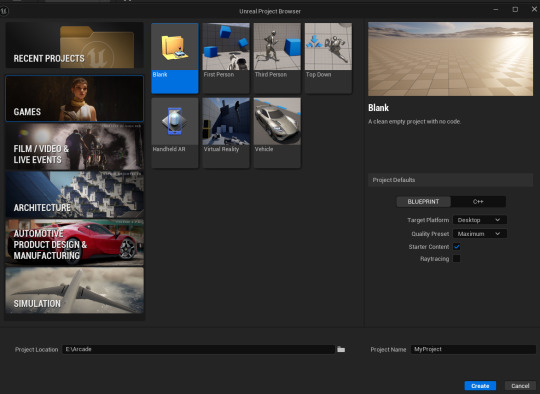
I named my game MA_FMP.
To start may game I used this guide but changed bits and pieces to fit my needs.
As I have no blueprints I have to make a new folder

I called this RTS for my game and then made a sub folder called core, this is for all my core elements like my camera.
Then we will add a blueprint and choose the game mode base

The reason I chose this is because it allows the game to be molded with how the game is played.
I have then gone back out and created a new folder called Player.
In this folder we will add the blueprint player controller.

Next I think I would normally add an actual player but as their wont be a main character I will make a pawn blueprint.
Next I will open the game mode I made earlier and change the default pawn class to blueprint player character. This means that the code I will make will work on all of my pawns( eg troops/units).
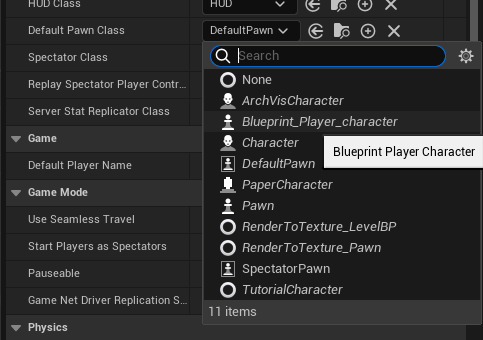
Then I will change the player controller to the one I made earlier. This will also mean I can control all of my pawns with the same code.

Then I next want my game mode I made to be used so I will go to my project settings.

I then went to maps and modes and changed the default game mode to the one I made.

Now I think I have a rough base work set for starting to create things.
With my camera I now need to be able to make it move. As when the game starts the camera is placed where you are and cant be moved.
I will open my pawn that I made for my camera and add a camera

I will then move the camera up and back then tilt it 30 degrees to get that iconic RTS look.
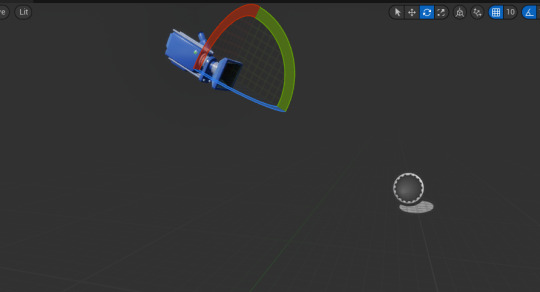
Now when I start my game the camera is looking down but can't move and starts where it is left in the editor.
To curb making it start at a certain position I will just add a player start.
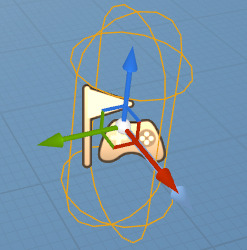
This worked but I then realized the camera was way too close to the ground. I then simply increased Hight.
I then realized that my camera would clip with the floor for some reason so I turned off collision test.

Now I want to add inputs to make the camera move.
To do this I will use a technique that I have learnt at home when creating another game.
I first opened the project settings and went to input. Then I made a new axis mapping called move forward and move right. Then I made it wasd and on s and a I made the scale -1 so it would do the opposite of the other action.
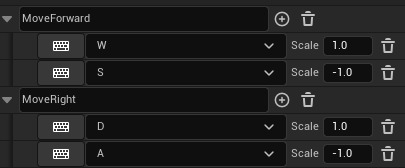
I now need to add this to my camera code.
I am going to first add it to my controller code.
First I will add the nodes I made for move forward and right. Then add get controlled pawn and add movement input. I connected this all up like this.
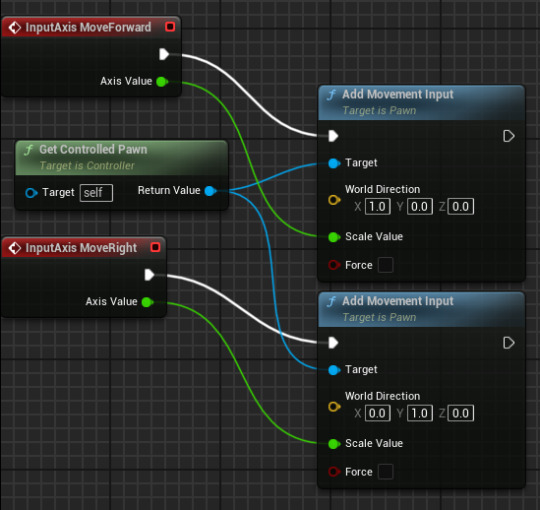
This then worked and my camera can now be controlled with wasd.
One thing I have noticed it that when the camera is facing a different way the controls don't change with it.
To change this we are going to add get control rotation. cast this to gat forward vector and struct the pins.

then put this into world direction on movement input for the move forward input.

Then for move right do the same thing but get right vector instead of forward.
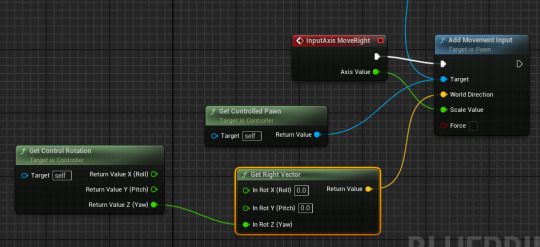

After compiling this it now works.
Next for the camera I want to make movement with the mouse.
First we will do what we did for the keyboard with axis mapping

Then I opened my player controller and added mouse movement

Next we need to know when the mouse goes to the side of the screen to then move it. First we need to lock the mouse to the screen when playing. to do this we will go into project settings.
Change the lock to always for viewport.

Then go back to the player controller and get mouse position. This casted to append which takes 2 things and puts them into 1 in this case it will be casted to a print string.
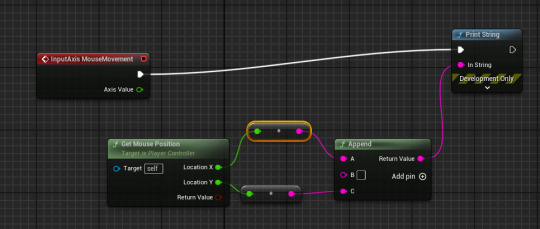
This bit of code will find where the mouse is and print the location on the screen. This can then be used to calculate a number with position. Then when it hits a number or beyond it can then move the character.
Another thing I want to add in is a scroll wheel. To do this I will get the viewport size. Then split the pin, this then meant we need to have a value from 0 to 1. From the viewport size add a divide from x and y.

this is then connected to the mouse position and append
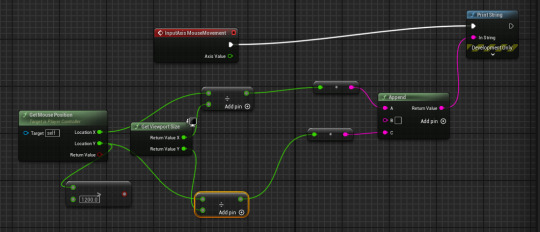
this now lets us calculate from 0 to 1. We can now know the bounds of the monitor.
This now works and changes based where the mouse is.

Next I copy this piece of code.

and add a less than on the first divide.

I have set this at 0.02 as on the x axis the mouse gets pretty close to the monitor edge and that is where I want it to trigger movement.
Next I want to make 2 variables to store the movements of the mouse for x and y.

I have made them a float as they will need to be storing numbers. Next I am going to promote the 0.02 to a variable and call it viewport Edge. I have made this so I can reference it when using it for movement.
Next add a branch coming from the print string with the condition bein the variable we promoted. From the true set the mouse right and make the value -1.

This code means that it will dictate if the number is lower than 0.02 and move it to the left as it is -1.
Next go to the the input axis right code we made earlier and disconnect the value from the movement input. Then from movement input cast select float. Connect input axis right to a on select float and the mouse right variable to B.

Now this kind of works but continually scrolls left. I think the reason is that the mouse start is 0,0 which is less that 0.02 so it goes left and I haven't added a return mechanic to move right. I think of of the branch after the print string I can just set right to 0 if the statement is false.
This now works great.
I now want to make this for the right.
To do this I can add a greater than from the x divide on mouse position. I then make this .98 which is the upper bound of the viewport. I then connect a second branch off of the first false one. The condition for that connects to the greater than. For the bottom pin on the greater than I add a minus and set it to 1. I then add the viewport edge to the minus.
Image limit capped move to part 2
0 notes
Text
Defense Communication System Market Set to Surge, Projected to Reach USD 120.62 Billion by 2033 with a CAGR of 9.9%
Demand for defense communication systems is estimated to progress at a CAGR of 9.9% from 2023 to 2033. This military communication market value is further expected to reach US$ 120.62 billion by 2033 growing from US$ 46.7 billion in 2023.
Acclaimed growth in industrial wireless communication technology has encouraged its integration with defense organizations with the growing need for tactical operations. The devices used are designed to work in harsh environments creating a distinguished market for themselves in recent years. With the increasing expansion of the worldwide naval forces, new and improved sonar systems are projected to be in high demand.
Key advancements in technologies have boosted the demand for military communication systems in North America, especially in the United States. The tactical network modernization strategy of the country includes building and fielding a network that is expeditionary moveable and well-protected. The plan aims to handle existing network difficulties while simultaneously actively researching next-generation solutions to stay ahead of possible competitors. So, the United States defense sector is totally focused on improving its tactical communication market and management systems.
In recent years, there has been a shift in designing and innovation of defense communication systems that can be utilized during internal security incidents. Several countries are ensuring that personnel assisting city police in tactical operations have access to the most up-to-date situational awareness and communication networks.
Key Takeaways from the Defense Communication System Market Study Report
North America is the prominent region for the development and adoption of defense communication systems acquiring a market share of 36.5% in 2022. It is mostly dominated by the United States which also leads the global market by contributing 20.5% of the revenue.
In 2022, Europe region followed North America in the adoption of defense communication by holding a market share of 24.8%. Germany was figured out to be the leading producer and supplier of defense communication systems by generating a 7.6% revenue share.
The demand for defense communication systems in the United Kingdom is projected to expand at an annual rate of 8.7% through 2033. Likewise, France is also anticipated to emerge as a profiteering region for the market players during the forecast years.
In Asia Pacific, China is projected to register a CAGR of 9.7% during the forecast years in sales of defense communication systems. Meanwhile, India is anticipated to witness a high growth rate of 12.1% during this period.
Based on product type, the market segment only for systems or components dominates the present market with a market share of 58.7%. While the defense communication services segment is poised to gain traction during the latter half of the projected period.
The Demand for defense communication systems in land forces is high than in the other two military branches. Though it currently holds a market share of 40.3%, the naval forces segment is expected to expand at a high pace.
Competitive Landscape for the Defense Communication System Market Players
General Dynamics, Airbus, QinetiQ, Rockwell Collins, and Lockheed Martin are some of the leading players in the global defense communication system market. Due to the emergence of new market players with government support and continuous private and public sector investments, the market is getting gradually competitive.
The development of new-generation defense communication devices with easy system integration is the main focus of leading manufacturers or market players nowadays. The emergence of IoT within the military network environment and the growing demand for mobile command systems are expected to increase these sales.
Key Segments Covered by Defense Communication System Industry Survey Report
Defense Communication System Industry Segment by Product Type:
Systems
Satellite Communication Systems
Radar & Sonar Systems
Radio Systems
Services
Consulting Services
Testing & Integration Services
Support & Maintenance Services
Defense Communication System Industry Segment by Communication Type:
Airborne Communications
Air-ground Communications
Underwater Communications
Ground-based Communications
Ship-borne Communications
Defense Communication System Industry Segment by Application:
ISR (Intelligence, Surveillance, and Reconnaissance)
Situational Awareness
Command & Control
Routine Operations
Emergency Medical Services
Other Applications
Defense Communication System Industry Segment by Military Branch:
Air Force
Land Force
Naval Force
Defense Communication System Industry Segment by Region:
North America
Latin America
Europe
East Asia
South Asia & Pacific
The Middle East & Africa (MEA)
0 notes
Text
Facts About Light Towers

This article will talk about facts about light towers. So, what exactly is a light tower? Light towers are versatile lighting arrangements containing a variety of electric lights attached to the highest point of a pole. Light towers are efficient to focus the light on an assigned region. Moreover, the pole connects to a trailer-like base that fills in as an anchor to adjust the tower, permitting the unit to tow it from one site to another.
Before the revelation of electricity, the most famous and unmistakable light towers were famous lighthouses high on the beach on shores all over the planet. Furthermore, these massive constructions have been around for many years and initially utilized fire to make light. After some time, lighthouses were retrofitted with electric lights. Various lighthouses are as yet in activity today.
American urban communities looked for a speedy and economical method for lighting their roads around the evening during the 1800s. In addition, urban communities’ methodology to address this issue was to raise lumbering “moon towers”- oil derrick-like designs with an intense light on top that attempted to wash whole towns in a moonlike sparkle.
As the gas-powered motor improved during the early and mid-twentieth century, technology was joined with the first plan of light towers. Furthermore, they developed into convenient light towers and stay an essential part of work destinations and different uses today.
Types
The way of a power source that produces power for the lights and the plan of the base characterizes the kind of light tower. In addition, any have enormous heavy trailer bases, while others utilize miniature cart-like bases. Types of light towers include:
Internal combustion engine-powered models such as compact standard duty, compact heavy-duty, and heavy industrial duty.
Battery-powered.
Solar-powered units contain a battery or multiple batteries to store solar power generated during the day.
Portable lighting carts with a small base and compact generator utilizing a shorter mast, allowing movement without hitching the apparatus to a vehicle.

Features of Light Towers
The most specific aspects of the light tower are the height of its pole and the power of its lights. The mix of the two details decides the area of illumination and intensity of light required inside a specific space. The power source decides the time allotment lighting will endure before refueling or re-energizing. Extra power choices, like solar panels, broaden use past the essential power source.
Choices to raise and lower poles are accessible. There are a few types of this element, like frameworks of folding posts or inflating and deflating air-based poles. Many sizes of light towers are accessible, which decides its transportability attributes. In addition, enormous light towers have a trailer chassis with a hitch and interstate prepared tires. Medium to minor units contains coordinated carts that are manually moveable.
#constructionequipment#findheavyequipmentandtrucks#excavator#motor grader#skid steer#heavyequipmentforsale
0 notes
Text
Select the Best Modular Kitchen for Effective Benefits

Source of info:https://www.regalokitchens.com/blog/select-the-best-modular-kitchen-for-effective-benefits
Introduction
If you're interested in achieving the greatest space in your kitchen for use and design, selecting a successful modular kitchen plan is necessary. At Regalo Kitchens, we are aware of the crucial function of a well designed kitchen that both improves cooking and fits your home's design. Take a look at our collection of personalized kitchen designs, each designed in order to improve both its design and its function while maintaining your kitchen as the focus of attention in your living space.
Learning about Modular Kitchen
The modular kitchen is a modernized and customizable kitchen design concept. You can customize the already developed cabinet components depending on your demands and available space in a variety of ways. These component parts are designed to help improve the finished look of the kitchen, provide more storage, and strengthen connection.
Check the Space in Kitchen
Choosing a suitable modular kitchen concept begins with knowing your kitchen space. Take measurements of your kitchen to get an idea of how much space you have available. Identify the layout of your kitchen, is it island-style, U-shaped, L-shaped, parallel, or straight? Each layout offers benefits of its own and can be modified to improve performance.
U-Shaped Kitchen
A U-shaped kitchen offers a lot of surface space and storage, which is quite beneficial for larger spaces. It makes switching between different kitchen areas easier by providing a continuous workflow. For individuals who enjoy cooking and want lots of room for their cooking activities, this setup is excellent.
L-Shaped Kitchen
An L-shaped modular kitchen can be arranged to fit a large or small space. It creates a useful and effective workplace through the use of two neighboring walls. This setup allows for simple movement and a variety of storage options. It is a popular choice for living areas with a spacious design.
Straight Kitchen
A straight kitchen is a simple yet effective concept for a limited area. A single wall is lined with cabinets and equipment in a straight line. Because it safeguards space, this arrangement is excellent for studio apartments or smaller homes.
Parallel Kitchen
In a parallel kitchen, often known as a galley kitchen, a passage runs between two parallel workstations. This is an extremely effective setup that provides ample space for cooking and preparation. For compact kitchens, it's a great choice.
Island Kitchen
An island kitchen has a center island unit and is a multifunctional design. The island can be used for extra storage, a breakfast bar, or cooking area. Large kitchens look great with this design, which adds a sense of elegance to your cooking space.
Focus on Storage Solutions
One of the key benefits of the modular kitchen is the practical storage choices it provides. Make sure that the storage options in your kitchen design are chosen based on your needs. Regalo Kitchens offers a variety of storage solutions, including tall units, corner units, and pull-out cabinets. These features increase the amount of space in your kitchen and keep it clean.
Pull-Out Cabinets
Pull-out cabinets would be an excellent upgrade to any modular kitchen. They make pots, pans, and other cooking supplies easily accessible, which makes cooking easier. These cabinets may be changed according to your unique storage requirements.
Corner Units
Corner units are built to make good use of unused corner space. They include special features that allow you to access items stored in the most distant parts of your kitchen, such as strange corners and spinning units.
Tall Units
Large containers are excellent for keeping kitchen supplies and cooking needs. They have a large storage capacity and can be improved with pull-out trays and moveable shelves to meet your specific demands.
Choose Quality Materials
The materials chosen to create your modular kitchen have a major effect on how effectively it operates. Regalo Kitchens exclusively uses high-quality materials that are easy to maintain and deal with for a long time. Choose fabrics that are heat, moisture and damage resistant.
Cabinet Materials
Select cabinets made of MDF (Medium Density Fiberboard), HDF (High Density Fiberboard), or marine plywood. These materials are durable and resistant to damage from use and strain.
Countertop Materials
Consider selecting solid surface, quartz, or granite for your countertops. These materials provide beauty to your kitchen while also providing durability.
Backsplash Materials
Wall tiles protect your walls from spills and splashes. Popular wall materials include stainless steel, glass, and ceramic tiles. They provide a fashionable highlight to your kitchen while being simple to maintain.
Optimize Lighting
To function properly, the kitchen needs enough light. Accent, natural, and task lighting can be used with different combinations to create a well-lit and appealing environment. Hidden lighting, pendant lighting, and under-cabinet lighting are popular choices for modular kitchen spaces.
Task Lighting
Task lighting is meant to show off specific areas where work such as cleaning, cooking, and cutting take place. For these jobs, light fixtures above the countertop and under-cabinet lights offer proper illumination.
Ambient Lighting
Soft lighting creates a welcoming and comfortable atmosphere in your kitchen. Overhead or ceiling-mounted lamps are recommended for providing best lighting in the space.
Accent Lighting
Accent lighting highlights unique characteristics in your kitchen, such as artwork or a backsplash. It adds depth and richness to your kitchen's decoration.
Conclusion
To choose the best modular kitchen plan, you need to do a thorough examination of your kitchen's space, storage options, appliances, materials, lighting, and customization options. At Regalo Kitchens, we are passionate about working with you to design a modular kitchen that goes above your expectations and suits your needs. With our assistance and high-quality materials, you can design a kitchen that is both functional and beautiful to look at. Accept the future of kitchen design with Regalo Kitchens to accomplish the perfect balance of luxury and benefits in your kitchen.
1 note
·
View note
Text
Select the Best Modular Kitchen for Effective Benefits
Source Of Info : https://www.regalokitchens.com/blog/select-the-best-modular-kitchen-for-effective-benefits

Introduction
If you're interested in achieving the greatest space in your kitchen for use and design, selecting a successful modular kitchen plan is necessary. At Regalo Kitchens, we are aware of the crucial function of a well designed kitchen that both improves cooking and fits your home's design. Take a look at our collection of personalized kitchen designs, each designed in order to improve both its design and its function while maintaining your kitchen as the focus of attention in your living space.
Learning about Modular Kitchen
The modular kitchen is a modernized and customizable kitchen design concept. You can customize the already developed cabinet components depending on your demands and available space in a variety of ways. These component parts are designed to help improve the finished look of the kitchen, provide more storage, and strengthen connection.
Check the Space in Kitchen
Choosing a suitable modular kitchen concept begins with knowing your kitchen space. Take measurements of your kitchen to get an idea of how much space you have available. Identify the layout of your kitchen, is it island-style, U-shaped, L-shaped, parallel, or straight? Each layout offers benefits of its own and can be modified to improve performance.
U-Shaped Kitchen
A U-shaped kitchen offers a lot of surface space and storage, which is quite beneficial for larger spaces. It makes switching between different kitchen areas easier by providing a continuous workflow. For individuals who enjoy cooking and want lots of room for their cooking activities, this setup is excellent.
L-Shaped Kitchen
An L-shaped modular kitchen can be arranged to fit a large or small space. It creates a useful and effective workplace through the use of two neighboring walls. This setup allows for simple movement and a variety of storage options. It is a popular choice for living areas with a spacious design.
Straight Kitchen
A straight kitchen is a simple yet effective concept for a limited area. A single wall is lined with cabinets and equipment in a straight line. Because it safeguards space, this arrangement is excellent for studio apartments or smaller homes.
Parallel Kitchen
In a parallel kitchen, often known as a galley kitchen, a passage runs between two parallel workstations. This is an extremely effective setup that provides ample space for cooking and preparation. For compact kitchens, it's a great choice.
Island Kitchen
An island kitchen has a center island unit and is a multifunctional design. The island can be used for extra storage, a breakfast bar, or cooking area. Large kitchens look great with this design, which adds a sense of elegance to your cooking space.
Focus on Storage Solutions
One of the key benefits of the modular kitchen is the practical storage choices it provides. Make sure that the storage options in your kitchen design are chosen based on your needs. Regalo Kitchens offers a variety of storage solutions, including tall units, corner units, and pull-out cabinets. These features increase the amount of space in your kitchen and keep it clean.
Pull-Out Cabinets
Pull-out cabinets would be an excellent upgrade to any modular kitchen. They make pots, pans, and other cooking supplies easily accessible, which makes cooking easier. These cabinets may be changed according to your unique storage requirements.
Corner Units
Corner units are built to make good use of unused corner space. They include special features that allow you to access items stored in the most distant parts of your kitchen, such as strange corners and spinning units.
Tall Units
Large containers are excellent for keeping kitchen supplies and cooking needs. They have a large storage capacity and can be improved with pull-out trays and moveable shelves to meet your specific demands.
Choose Quality Materials
The materials chosen to create your modular kitchen have a major effect on how effectively it operates. Regalo Kitchens exclusively uses high-quality materials that are easy to maintain and deal with for a long time. Choose fabrics that are heat, moisture and damage resistant.
Cabinet Materials
Select cabinets made of MDF (Medium Density Fiberboard), HDF (High Density Fiberboard), or marine plywood. These materials are durable and resistant to damage from use and strain.
Countertop Materials
Consider selecting solid surface, quartz, or granite for your countertops. These materials provide beauty to your kitchen while also providing durability.
Backsplash Materials
Wall tiles protect your walls from spills and splashes. Popular wall materials include stainless steel, glass, and ceramic tiles. They provide a fashionable highlight to your kitchen while being simple to maintain.
Optimize Lighting
To function properly, the kitchen needs enough light. Accent, natural, and task lighting can be used with different combinations to create a well-lit and appealing environment. Hidden lighting, pendant lighting, and under-cabinet lighting are popular choices for modular kitchen spaces.
Task Lighting
Task lighting is meant to show off specific areas where work such as cleaning, cooking, and cutting take place. For these jobs, light fixtures above the countertop and under-cabinet lights offer proper illumination.
Ambient Lighting
Soft lighting creates a welcoming and comfortable atmosphere in your kitchen. Overhead or ceiling-mounted lamps are recommended for providing best lighting in the space.
Accent Lighting
Accent lighting highlights unique characteristics in your kitchen, such as artwork or a backsplash. It adds depth and richness to your kitchen's decoration.
Conclusion
To choose the best modular kitchen plan, you need to do a thorough examination of your kitchen's space, storage options, appliances, materials, lighting, and customization options. At Regalo Kitchens, we are passionate about working with you to design a modular kitchen that goes above your expectations and suits your needs. With our assistance and high-quality materials, you can design a kitchen that is both functional and beautiful to look at. Accept the future of kitchen design with Regalo Kitchens to accomplish the perfect balance of luxury and benefits in your kitchen.
1 note
·
View note
Text
Autonomous Vehicle Chassis
July 12, 2024
by dorleco
with no comment
Autonomous Vehicle Technology
Edit
Introduction
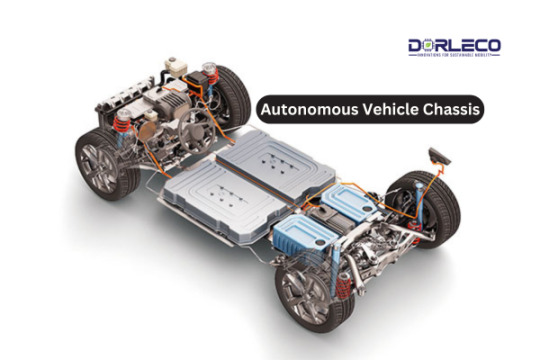
The chassis of autonomous vehicles is a crucial component that supports and integrates the cutting-edge technology required for autonomous driving. Considering the following elements is crucial when it comes to autonomous vehicle chassis:
1. Sensor Integration:
Autonomous vehicles use a variety of sensors to sense their surroundings, such as lidar, radar, cameras, and ultrasonic. These sensors need to be placed precisely inside the chassis during construction to reduce interference and improve visibility.
2. Computer hardware:
The Autonomous Vehicle Chassis contains the computational hardware — powerful processors and control units, for example — needed to handle the massive amount of data collected by the sensors. These parts frequently require specialized cooling and mounting systems.
3. Architecture for Electrical Systems:
Autonomous vehicles require complex electrical systems to regulate the connection between sensors, actuators, and the central processing unit. The chassis must have a robust electrical architecture to ensure dependable connectivity and data transfer.
4. Systems of Redundancy:
Redundancy mechanisms are often incorporated into chassis designs due to the many moving parts involved in autonomous driving. This includes more power supply systems, computer systems, and sensors to increase the vehicle’s dependability and security.
5. Distribution of Power:
Electricity is needed for actuators, processing systems, and sensors to work. All components need a steady and reliable power supply, so the chassis design needs to have a power distribution system that works.
6. Vehicle Communication:

Autonomous vehicles often require communication with other vehicles and the infrastructure to facilitate cooperative driving and enhance overall safety. The Autonomous Vehicle Chassis ought to facilitate the integration of the antenna and communication module.
7. Safety and Structural Integrity:
The safety of the passengers in an accident is contingent upon the chassis retaining a high degree of structural integrity. To protect fragile equipment and passengers, autonomous vehicles need to be designed with crashworthiness and impact absorption in mind.
8. Adaptive Suspension Systems:
Suspension systems on some autonomous cars can be adjusted to optimize ride quality and vehicle stability while driving on their own. These technologies can instantly change the suspension settings based on the driving conditions and the condition of the road.
9. Interior Design and User Experience:
The chassis design affects the interior arrangement of autonomous vehicles. The absence of typical driver-focused elements on the chassis allows for innovative interior design, like moveable seats and entertainment systems that enhance the entire user experience.
10. Compliance with Rules:
The legal and regulatory requirements for self-driving technology are taken into consideration throughout the design of the autonomous vehicle chassis. Autonomous vehicles that adhere to safety regulations and standards will be able to drive on public roads.
Autonomous Vehicle Chassis Drawbacks
While autonomous vehicle technology has great promise, there are several challenges and potential drawbacks associated with the chassis of these vehicles. Here are a few noteworthy drawbacks:
1. The price of technology
Redundancy systems, computing hardware, and advanced sensor integration can raise the cost of the autonomous car chassis. This expense may keep more customers from utilizing autonomous technologies.
2. Complexity of Reliability:
Autonomous vehicles incorporate sophisticated technology like computers, sensors, and communication modules into their chassis. Maintenance costs may rise if these intricate parts require specialized training and equipment for upkeep and repairs.
3. Limitations on Sensations:
Existing sensor technologies, including radar and lidar, have certain limitations, especially in inclement weather conditions like snow or prolonged rain. The high reliance of the chassis’s vision and navigational systems on sensor inputs may compromise the dependability of autonomous systems.
4. Cyber security issues:

Driverless automobiles are susceptible to cyber security threats. The possibility of hacking and illegal access to vital systems rises as the chassis becomes more interconnected and dependent on data interchange, which might raise privacy and safety issues.
5. Infrastructure Dependence:
The efficiency of self-driving cars depends on an established and standardized infrastructure, such as communication networks, signage, and road markings. Autonomous vehicle chassis performance can be affected in areas with poor infrastructure or conflicting norms.
6. Ethical Dilemma:
Autonomous vehicles are built to react quickly in a range of circumstances, including potential crashes. There are moral dilemmas when deciding how to prioritize passenger safety over pedestrian safety, which calls into question the responsibility and decision-making algorithms integrated into the chassis.
7. Acceptance and Belief by the Public:
Gaining public trust is one of the largest obstacles facing autonomous automobile technology. Potential customers’ reluctance and mistrust stemming from concerns about cyber security, safety, and chassis dependability may impede widespread adoption.
8. Limited Autonomy in Complex Environments:

Autonomous vehicles may encounter difficulties in complex or unpredictable environments, such as crowded urban traffic, construction zones, or unexplored land. There could be difficulties for the chassis while navigating circumstances that require human intuition and dexterity.
Conclusion:
In conclusion, an important factor influencing how transportation will develop in the future is the chassis of autonomous cars. The design of the chassis for autonomous vehicles has several advantages, including sophisticated sensor integration, processing power, and safety measures, but it also has some difficulties and disadvantages.
Positively, the chassis of autonomous vehicles make it easier to integrate cutting-edge technologies, allowing cars to sense their environment, react in real-time, and navigate safely on their own without assistance from a human. The sensors, computer hardware, and communication networks that are the foundation of autonomous driving capabilities can be deployed with the help of the chassis. A more comfortable and user-friendly experience is also a result of advancements in energy efficiency, interior design, and adaptable suspension systems.
However, there are still issues that need to be resolved, such as the expensive cost of technology, the difficulty of maintaining it, the limitations of the sensors, cyber security issues, and the requirement for strong infrastructure and legal frameworks. The widespread deployment of autonomous vehicle chassis is made more difficult by factors like as ethical conundrums, public acceptance and faith in autonomous vehicles, and environmental concerns.
To fully realize the potential of autonomous vehicles, it will be imperative to solve these obstacles as the automotive industry and technology advance. Overcoming obstacles and guaranteeing the safe, effective, and responsible integration of autonomous vehicle chassis into our transportation systems requires continued research, industry collaboration, advancements in sensor technologies, and the creation of comprehensive regulatory frameworks. In the end, the transition to completely autonomous vehicles necessitates a balanced strategy that takes into account societal, ethical, and legal factors in addition to technological progress.
#Autonomousvehicle#chassis#Drivebywire#evcc#ccu#evse#ProgrammableVCU#embeddedsystem#Dorleco#VCUSupplier#VCU#Controlsystem
0 notes
Text
Urban Oasis: Navigating Contemporary Living with Modular Designs
Introduction
In the fast-paced urban landscape, where space is often a premium commodity, the demand for versatile and space-efficient solutions has led to the rise of modular designs. These innovative and adaptable designs cater to the modern lifestyle, offering flexibility, functionality, and a touch of aesthetic appeal. This comprehensive guide explores the concept of urban oasis through the lens of modular designs, showcasing how these versatile solutions can transform contemporary living spaces.
Understanding Modular Designs
Defining Modular Designs
Modular designs involve creating components or units that can be assembled or arranged in various ways to build a flexible and functional structure. This approach contrasts with traditional fixed designs, providing a dynamic and adaptable solution to the evolving needs of urban dwellers.
Key Characteristics of Modular Designs
Flexibility: Modular designs offer the freedom to customize and rearrange elements according to changing requirements, ensuring a living space that evolves with its inhabitants.
Space Efficiency: Maximizing the use of available space is a hallmark of modular designs. These solutions often incorporate smart storage options and multifunctional furniture to optimize every square foot.
Sustainability: Many modular designs focus on sustainability by using eco-friendly materials and promoting longevity. The ability to reconfigure and reuse modular components also contributes to reducing waste.
Innovative Technology Integration: Some modular designs incorporate technology seamlessly, providing smart solutions for modern living. This may include home automation, space-saving gadgets, and multifunctional appliances.
Exploring Modular Living Spaces
1. Modular Furniture for Versatile Living Rooms
Adaptable Seating:
Transforming Sofas: Modular sofas with adjustable components allow for diverse seating arrangements, catering to various social settings.
Multifunctional Coffee Tables: Coffee tables with storage compartments or adjustable heights enhance functionality in the living room.
Flexible Storage Solutions:
Modular Shelving Systems: Customizable shelving units accommodate changing storage needs and serve as aesthetic focal points.
Transformative Cabinets: Cabinets with modular compartments or sliding panels offer adaptable storage for various items.
Entertainment Centers:
Media Walls: Modular media walls integrate storage, display, and entertainment components, offering a streamlined and organized look.
Adjustable TV Stands: TV stands with adjustable heights or swivel mechanisms enhance viewing experiences in multifunctional living spaces.
2. Modular Kitchens for Efficiency and Style
Flexible Kitchen Layouts:
Customizable Cabinets: Modular kitchen cabinets and islands with interchangeable elements enable users to adapt the layout based on culinary needs.
Foldable Countertops: Foldable countertops or extensions provide additional workspace when required and can be neatly tucked away when not in use.
Smart Storage Solutions:
Pull-Out Pantries: Modular pull-out pantries maximize storage space while ensuring easy access to ingredients and kitchen essentials.
Stackable Containers: Stackable and modular storage containers maintain organization within cabinets and drawers.
Multipurpose Kitchen Islands:
Convertible Islands: Kitchen islands with modular features, such as extendable countertops or built-in seating, serve as versatile workstations and social hubs.
Mobile Islands: Moveable kitchen islands on wheels allow for flexible positioning, adapting to the changing flow of activities in the kitchen.
3. Modular Bedrooms for Tranquil Retreats
Adaptable Bed Configurations:
Modular Bed Bases: Bed bases with adjustable components cater to various sleeping preferences and can be modified for different room layouts.
Convertible Beds: Folding or wall-mounted beds offer space-saving solutions for compact bedrooms, transforming the room's functionality.
Customizable Wardrobe Systems:
Modular Wardrobe Units: Wardrobe systems with interchangeable shelves, drawers, and hanging spaces accommodate evolving storage needs.
Sliding Door Options: Sliding or folding wardrobe doors save space while providing easy access to clothing and accessories.
Compact Vanity Areas:
Foldaway Vanities: Vanity units that can be folded or concealed when not in use contribute to a clutter-free bedroom environment.
Modular Mirrors: Mirrors with adjustable angles or hidden storage enhance the functionality of vanity areas.
4. Modular Bathrooms for Efficient Use of Space
Modular Vanity Units:
Floating Vanities: Wall-mounted vanities create a sense of spaciousness in small bathrooms and facilitate easy cleaning.
Stackable Storage: Stackable and modular storage solutions in bathrooms optimize vertical space for toiletries and essentials.
Convertible Shower Spaces:
Foldable Shower Screens: Shower screens that can be folded or retracted contribute to an open and airy feel in compact bathrooms.
Multipurpose Shower Fixtures: Modular shower fixtures with adjustable heads or additional functionalities enhance the bathing experience.
Space-Efficient Toilets:
Wall-Mounted Toilets: Wall-mounted toilets save floor space and simplify cleaning, contributing to a streamlined bathroom design.
Built-In Storage: Concealed storage behind toilet panels or within walls maximizes space efficiency in smaller bathrooms.
The Aesthetic Appeal of Modular Designs
1. Incorporating Aesthetics with Functionality
Unified Design Language:
Consistent Color Palette: Maintaining a consistent color palette throughout modular designs creates a cohesive and visually appealing aesthetic.
Sleek and Minimalist Designs: Embracing minimalist designs contributes to an uncluttered and modern look, aligning with the principles of contemporary living.
Creative Configurations:
Geometric Patterns: Incorporating geometric patterns in modular designs adds visual interest and a touch of contemporary flair.
Mixing Materials: Experimenting with a variety of materials, such as wood, metal, and glass, enhances the visual appeal of modular furniture and spaces.
2. Personalization in Modular Design
Customization Options:
Configurable Furniture Sets: Modular furniture sets that allow users to mix and match components empower them to personalize their living spaces.
Tailored Storage Solutions: Modular storage units with customizable configurations cater to individual organizational preferences.
Expressive Decor Elements:
Decorative Modular Panels: Decorative panels or screens with modular features can be arranged to create artistic focal points in a room.
Artistic Lighting Fixtures: Modular lighting fixtures with adjustable components add a touch of sophistication and allow for personalized illumination.
3. Bringing Nature Indoors
Vertical Gardens:
Modular Planters: Vertical planters with modular designs bring a touch of nature indoors while utilizing vertical spaces.
Living Wall Systems: Incorporating living wall systems enhances air quality and creates a refreshing visual impact.
Natural Materials:
Wooden Accents: Introducing modular furniture with wooden accents adds warmth and a natural element to contemporary interiors.
Stone and Marble Finishes: Modular designs with stone or marble finishes contribute to a luxurious and nature-inspired aesthetic.
Embracing Sustainability in Modular Living
1. Eco-Friendly Materials
Recyclable Components:
Recycled Plastic: Modular designs using recycled plastic contribute to sustainability while offering versatility and durability.
Bamboo Furniture: Bamboo, a rapidly renewable resource, is an eco-friendly option for modular furniture, providing strength and aesthetic appeal.
Upcycled Furniture:
Repurposed Elements: Upcycled modular furniture crafted from repurposed materials aligns with environmentally conscious living.
Reclaimed Wood: Using reclaimed wood in modular designs not only reduces waste but also adds character and uniqueness to the furniture.
2. Longevity and Durability
High-Quality Construction:
Durable Framework: Investing in modular designs with sturdy frameworks ensures longevity, reducing the need for frequent replacements.
Quality Finishes: Opting for quality finishes on modular furniture contributes to its resilience against wear and tear.
Timeless Design:
Versatile Styles: Choosing modular designs with timeless styles ensures that they remain relevant and aesthetically pleasing over the years.
Adaptable Configurations: Modular furniture that allows for easy reconfiguration can adapt to changing trends and design preferences.
The Future of Urban Living: Modular Designs Redefined
1. Smart Integration for Seamless Living
Connected Living Spaces:
Home Automation: Integrating modular designs with smart home technology enhances convenience and efficiency in daily living.
Multi-Functional Smart Furniture: Smart furniture with built-in technology, such as charging ports or built-in speakers, exemplifies the fusion of functionality and connectivity.
2. Collaborative Living Concepts
Community-Focused Spaces:
Co-Living Furniture: Modular furniture designed for co-living spaces emphasizes communal living and fosters a sense of community.
Shared Modular Amenities: Shared modular amenities, such as communal kitchens or flexible workspace configurations, cater to collaborative living arrangements.
3. Virtual Reality in Design Planning
Design Visualization:
Virtual Room Configurators: Virtual reality tools that allow users to visualize and customize modular designs before purchasing contribute to informed decision-making.
Design Collaboration Platforms: Online platforms that facilitate collaborative design planning enable users to share ideas and customize modular layouts.
Navigating the Urban Oasis: Tips for Incorporating Modular Designs
1. Assessing Space and Functionality
Room Analysis: Understand the specific needs and functions of each room to determine the most suitable modular solutions.
Space Measurement: Measure the available space accurately to ensure that modular components fit seamlessly into the environment.
2. Personalizing Your Living Spaces
Reflecting Personal Style: Select modular designs that align with your personal style and preferences, ensuring that your living spaces feel uniquely yours.
Mix and Match: Experiment with mixing and matching modular components to create a customized and eclectic look.
3. Prioritizing Functionality
Identifying Needs: Prioritize functionality by identifying the specific needs of each living space, whether it's storage, versatility, or space optimization.
Multi-Functional Furniture: Choose multi-functional modular furniture to maximize utility and adaptability.
4. Sustainable Choices for Responsible Living
Material Selection: Opt for modular designs crafted from eco-friendly and sustainable materials to contribute to a greener lifestyle.
Long-Term Investment: Consider modular furniture as a long-term investment, focusing on durability and timeless design.
5. Embracing Technological Integration
Smart Furniture: Explore modular designs that seamlessly integrate with smart home technology, enhancing the overall living experience.
Energy-Efficient Solutions: Choose modular designs with energy-efficient features to promote sustainability in daily living.
Conclusion
In the bustling urban landscape, where space constraints and dynamic lifestyles prevail, the concept of an urban oasis becomes increasingly relevant. Modular designs emerge as the guiding force, providing a versatile, sustainable, and aesthetically pleasing solution to contemporary living challenges. As we navigate the urban jungle, the integration of modular designs transforms our living spaces into adaptive, functional, and personalized sanctuaries—a true reflection of the evolving needs and aspirations of the modern dweller. Embrace the modular revolution, and let your urban oasis thrive amidst the ebb and flow of city life.
0 notes
Text




Paaaarriiisss 🤎
Paris, the City of Love, is a place that captivates the hearts of millions with its ethereal beauty and romantic atmosphere. It is a city that has inspired countless artists, writers, and dreamers throughout history. As Ernest Hemingway once said, "If you are lucky enough to have lived in Paris as a young man, then wherever you go for the rest of your life, it stays with you, for Paris is a moveable feast." Paris is not just a physical place; it becomes a part of your soul, forever embedded in your memories and shaping your perspective on life. And at the heart of this enchanting city lies the iconic Stade De France, a symbol of strength, unity, and the indomitable spirit of the French people. It is a stadium that has witnessed historic sporting moments and has brought people together from all walks of life. Stade De France represents the fusion of cultures, the celebration of diversity, and the power of sports to unite nations. Paris and Stade De France are not just physical landmarks; they are symbols of passion, resilience, and the pursuit of dreams.
Paaaarriiisss 🤎 July 15, BLACKPINK performed at the iconic Stade De France in Paris, France, as part of our 'Born Pink' world tour. It was an unforgettable night filled with incredible performances and unforgettable moments. We kicked off the concert with our powerful song "Pink Venom," setting the stage on fire right from the start. The energy in the stadium was electrifying, and we could feel the love and support from our fans. We performed some of our biggest hits like "How You Like That," "Pretty Savage," and "Whistle," and the crowd went wild with excitement. I had the honor of wearing a stunning top from Saint Laurent's 2023 Spring/Summer collection during the concert. It made me feel confident and ready to give my all on stage. I performed my solo songs "Gone" and "On the Ground," and it was an emotional and empowering moment for me. The audience was captivated by the music and my dance moves, and their cheers and applause fueled my performance.
What made this concert even more special is that we made history as the first girl group to headline a sold-out show at Stade De France. It was a huge milestone for us, and we couldn't have done it without the love and support of our amazing fans. The energy and passion they brought to the concert were incredible, and we felt so grateful to be able to share this moment with them. The entire show was a spectacle, with an extravagant stage setup and powerful performances from each member. We wanted to create an unforgettable experience for our fans, and based on the thunderous applause and the smiles on their faces, I think we succeeded. Thank you to everyone who came to the concert and supported us.
0 notes